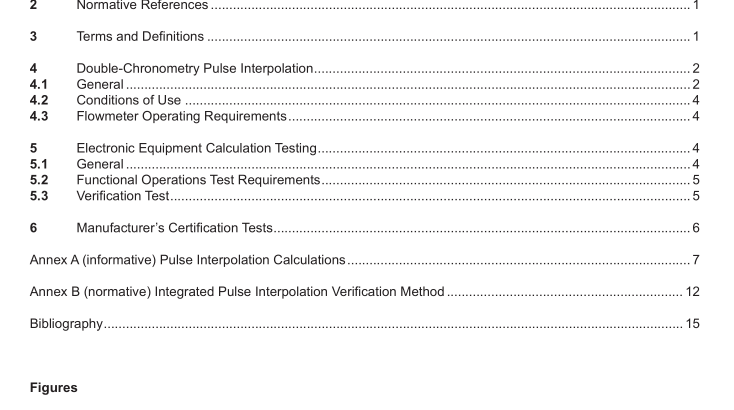API MPMS 4.6:2021 pdf free download.Manual of Petroleum Measurement Standards Chapter 4.6
The use of double-chronometry in meter proving requires that the discrimination of the time intervals T 1 and T 2 be better than ±0.01 %. The time periods T 1 and T 2 shall therefore be at least 20,000 times greater than the reference period T c of the clock that is used to measure the time intervals. The clock frequency F c has to be high enough to ensure that both the T 1 and T 2 timers accumulate at least 20,000 clock pulses during the prove operation. This is not difcult to achieve, as current electronics technology used for pulse interpolation typically uses clock frequencies in the megahertz range.
4.2 Conditions of Use
4.2.1 The interpolated number of pulses, N 1 , will not be a whole number. N 1 is therefore rounded of as described in API MPMS Chapter 12.2 [5] .
4.2.2 Pulse interpolation methods are based on the assumptions that actual fow rate does not change substantially during the period between successive meter pulses, and each pulse represents the same volume (refer to API MPMS Chapter 4.2, Annex E). To maintain the validity of these assumptions, periodic fuctuations in the fow rate during the proving operation shall be minimized.
4.2.3 Because pulse interpolation equipment contains high-speed counters and timers, it is important that equipment be installed in accordance with the manufacturer’s installation instructions, thereby minimizing the risk of counting spurious pulses caused by electrical interference occurring during the proving operation. Refer to API MPMS Chapter 5.4 [3] , API MPMS Chapter 5.5 [4] , and other sections of API MPMS Chapter 4 [1] for more details.
4.3 Flowmeter Operating Requirements The fowmeter that is being proved and is providing the pulses for the pulse interpolation system shall meet the following requirements:
a) If the pulse stability at constant fow rate cannot be maintained within the limits given in API MPMS Chapter 4.2, Annex E, the fowmeter can be used with a pulse interpolation system only at a lower overall accuracy level. In this case, a revised calibration accuracy level should be evaluated or multiple runs with summation techniques employed. See API MPMS Chapter 4.8 [2] .
b) The meter pulse continuity in fowmeters should be in accordance with API MPMS Chapter 4.2, Annex E. The generated fowmeter pulse can be observed by an oscilloscope, whose time base is set to a minimum of one full cycle, to verify meter pulse continuity of the fowmeter.
c) The repeatability of the fowmeter will be a function of the variability in pulse frequency at a constant fow rate. To apply pulse interpolation techniques to any fowmeter, the meter pulse stability of the fowmeter should be in accordance with API MPMS Chapter 4.2, Annex E.
d) The size and shape of the signal generated by the fow meter should be suitable for presentation to the pulse interpolation system in terms of duty cycle, proportionality, and interpulse spacing. If necessary, the signal should undergo amplifcation and shaping before it enters the pulse interpolation system.
5 Electronic Equipment Calculation Testing
5.1 General The proper operation of pulse interpolation electronics is crucial to accurate meter proving. A functional feld test of the total system shall be performed periodically to ensure that the equipment is calculating correctly. This may simply be a hand calculation verifying that the equipment correctly calculates the interpolated pulses per Section 4, or if need be, a complete verifcation test as described in 5.3 if a problem is suspected.
5.2 Functional Operations
Test Requirements The system being used should provide diagnostic data displays or printed data reports that show the value of all parameters and variables necessary to verify proper operation of the system by hand calculation. These parameters and variables include, but are not limited to, timers T 1 and T 2 , the number of whole fowmeter pulses N m , and the calculated interpolated pulses N 1 . Using the diagnostic displays provided, the unit should be functionally tested by performing a sequence of prove runs and analyzing the displayed or printed results (refer to Annex B).API MPMS 4.6 pdf download.API MPMS 4.6:2021 pdf free download
